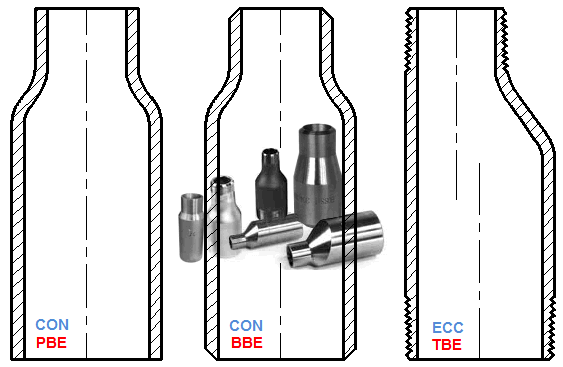Pipe ( nipples) ends
This article describes the available and different pipe end configurations, the scenarios in which they are most often used and the factors to consider when choosing a specific pipe end. The type of pipe end chosen determines how the pipe connects to other components and for which applications and components the pipe is best suited.
Most commonly used pipe ends
Pipe ends usually fall into one of the following standard three categories..
- Threaded Ends (TE)
- Bevelled Ends (BE)
- Plain Ends (PE)
- In contrast, a pipe may have a description of TBE, which means both ends are threaded.
- A pipe, on the other hand, may have a description BBE, meaning that both ends are provided with bevelled ends A
- pipe, on the other hand, may have a description PBE, meaning that both ends are provided with plain ends

|
||
| TE | BE | PE |
The listed pipe ends are all standard configurations and apply to single random lengths of approximately 4.8 to 7 metres and to double random lengths of approximately 11 to 13 metres.
Shorter and longer lengths are available with several ends, but for calculation purposes it is wise to use these standard lengths; other lengths with different ends are available, but are likely to be more expensive.
Most commonly used pipe nipples ends
compared to pipe, pipe nipples are available in all kinds of standard variations.
The table below shows the correct abbreviations, with the explanatory text.
| TBE | Threaded Both Ends |
| BBE | Bevelled Both Ends |
| PBE | Plain Both Ends |
| TOE/BOE | Threaded One End Bevelled One End |
| TOE/POE | Threaded One End Plain One End |
| BOE/TOE | Bevelled One End Threaded One End |
| BOE/POE | Bevelled One End Plain One End |
| POE/TOE | Plain One End Threaded One End |
| POE/BOE | Plain One End Plain Bevelled One End |
| by the way nipple TOE/BOE is the same as nipple BOE/TOE etc. |
|
| unwanted | |
| BET | Both Ends Threaded |
| OET/OEB | One End Threaded One End Bevelled |
| OEP/OEB | One End Plain One End Bevelled |
When ordering a pipe nipple In addition to specifying the right ends, it is necessary to determine and correctly specify the diameter, wall wall thickness and material.
Most common swage nipples ends
| TBE | Threaded Both Ends |
| BBE | Beveled Both Ends |
| PBE | Plain Both Ends |
| TLE | Threaded Large End |
| TSE | Threaded Small End |
| BLE | Beveled Large End |
| BSE | Beveled Small End |
| PLE | Plain Large End |
| PSE | Plain Small End |

Generally, there is no problem if both ends are of the same type. However, if ends of two different types are needed, the nomenclatures must be combined correctly.
For example, ordering a swage nipple PLE/TLE would not make sense, because both refer to the large diameter end. The correct one would be PLE/TSE, which stands for a swage nipple with a large plain end and a threaded smaller end, or a similar combination, depending on the application.
Besides specifying the correct ends, it is necessary to define whether it should be a concentric or eccentric swage nipple. and to specify the diameters, wall thickness and material.correctly.
